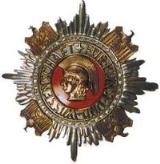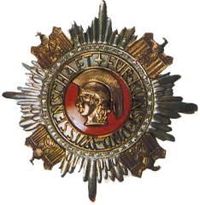
German National Prize for Art and Science
Encyclopedia

Adolf Hitler
Adolf Hitler was an Austrian-born German politician and the leader of the National Socialist German Workers Party , commonly referred to as the Nazi Party). He was Chancellor of Germany from 1933 to 1945, and head of state from 1934 to 1945...
in 1937 as a replacement for the Nobel Prize
Nobel Prize
The Nobel Prizes are annual international awards bestowed by Scandinavian committees in recognition of cultural and scientific advances. The will of the Swedish chemist Alfred Nobel, the inventor of dynamite, established the prizes in 1895...
(he had forbidden Germans to accept the latter award in 1936 after an anti-Nazi German writer, Carl von Ossietzky
Carl von Ossietzky
Carl von Ossietzky was a German pacifist and the recipient of the 1935 Nobel Peace Prize. He was convicted of high treason and espionage in 1931 after publishing details of Germany's alleged violation of the Treaty of Versailles by rebuilding an air force, the predecessor of the Luftwaffe, and...
, was awarded the 1935 Nobel Peace Prize). The award was designed by Müller-Erfurt and created in the form of a pendant
Pendant
A pendant is a loose-hanging piece of jewellery, generally attached by a small loop to a necklace, when the ensemble may be known as a "pendant necklace". A pendant earring is an earring with a piece hanging down. In modern French "pendant" is the gerund form of “hanging”...
studded with diamonds. In fact, it was so heavy that a special mount had to be created so that it would stay on the wearer's jacket. An extremely ornate presentation box contained the pendant and a wide red and white sash also complemented the award.
There was an image of a Greek hoplite
Hoplite
A hoplite was a citizen-soldier of the Ancient Greek city-states. Hoplites were primarily armed as spearmen and fought in a phalanx formation. The word "hoplite" derives from "hoplon" , the type of the shield used by the soldiers, although, as a word, "hopla" could also denote weapons held or even...
on the obverse of the prize medal and the lettering: FÜR KUNST UND WISSENSCHAFT (For art and science) was emblazoned on the medal as well. In addition to the medal and award sash, a cash prize of 100,000 Reichsmark
German reichsmark
The Reichsmark was the currency in Germany from 1924 until June 20, 1948. The Reichsmark was subdivided into 100 Reichspfennig.-History:...
was also given.
The total number of National Prizes awarded between 1937 and 1939 was nine, thus making this award one of the rarest awards given in the Third Reich, even rarer than the German Order
German Order (decoration)
The German Order was the most important award that the Nazi Party could bestow on an individual for "duties of the highest order to the state and party". This award was first made by Adolf Hitler posthumously to Reichsminister Fritz Todt at his funeral in February, 1942...
.
Awardees
The German National Prize was awarded to a total of nine people.1937
The award announcement was held on September, 7 1937 and the award ceremony took place on January 30, 1938 by Adolf Hitler in the Reich Chancellery
Reich Chancellery
The Reich Chancellery was the traditional name of the office of the Chancellor of Germany in the period of the German Reich from 1871 to 1945...
The first five winners were:
- Architect Paul Ludwig Troost (posthumously)
- Reich Leader Alfred RosenbergAlfred Rosenberg' was an early and intellectually influential member of the Nazi Party. Rosenberg was first introduced to Adolf Hitler by Dietrich Eckart; he later held several important posts in the Nazi government...
- Explorer Wilhelm FilchnerWilhelm FilchnerWilhelm Filchner was a German explorer.At the age of 21, he participated in his first expedition, which led him to Russia. Two years later, he travelled alone and on horseback through the Pamir Mountains, from Osh to Murgabh to the upper Wakhan to Tashkurgan and back...
- Surgeons August BierAugust BierAugust Karl Gustav Bier was a German surgeon and a pioneer of spinal anaesthesia. After professorships in Greifswald and Bonn, Bier became a professor at the Charité in Berlin.-Spinal anesthesia:...
and Ferdinand SauerbruchFerdinand SauerbruchErnst Ferdinand Sauerbruch was a German surgeon.Sauerbruch was born in Barmen , Germany. He studied medicine at the Philipps University of Marburg, the University of Greifswald, the Friedrich Schiller University of Jena, and the University of Leipzig, from the last of which he graduated in 1902...
(shared award)
1938
The award announcement was made on 6 September 1938, the surrender on 30 January 1939 by Adolf Hitler in the Chancellery. The winners of this second year were:
- General Inspector of the German roads and head of the military construction Organisation TodtOrganisation TodtThe Todt Organisation, was a Third Reich civil and military engineering group in Germany named after its founder, Fritz Todt, an engineer and senior Nazi figure...
Fritz TodtFritz TodtFritz Todt was a German engineer and senior Nazi figure, the founder of Organisation Todt. He died in a plane crash during World War II.- Life :Todt was born in Pforzheim to a father who owned a small factory... - The automaker Ferdinand PorscheFerdinand PorscheFerdinand Porsche was an Austrian automotive engineer and honorary Doctor of Engineering. He is best known for creating the first hybrid vehicle , the Volkswagen Beetle, and the Mercedes-Benz SS/SSK, as well as the first of many Porsche automobiles...
- the aircraft designers Willy MesserschmittWilly MesserschmittWilhelm Emil "Willy" Messerschmitt was a German aircraft designer and manufacturer. He was born in Frankfurt am Main, the son of a wine merchant...
and Ernst HeinkelErnst HeinkelDr. Ernst Heinkel was a German aircraft designer, manufacturer, Wehrwirtschaftführer in the Third Reich, and member of the Nazi party. His company Heinkel Flugzeugwerke produced the Heinkel He 178, the world's first turbojet aircraft and jet plane, and the Heinkel He 176, the first rocket aircraft...
(shared award).

